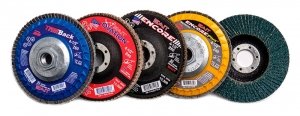Flap Discs and Wheels: What to Know and How to Pick the Right Tool for the Job

Flap discs and flap wheels come in a variety of shapes and sizes, and knowing which is right can make it tricky to determine the right product for your application.
For example, if you look at our flap discs and wheels product page, you’ll see nine different product categories, all for varying needs and tasks.
While we encourage you to use our application search to find the abrasive you need, today we’re going to break down some of the common terms you’ll see on our wheels and discs to help you understand your options.
What is a Flap Disc?
Flap discs were developed as an alternative to resin bonded grinding wheels and fiber discs. Due to changes in the welding processes over the years (i.e. smaller welds from TIG and MIG wire), a flap disc requires less weld to be removed than other processes (stick welding). With a flap disc, the operator can still remove the weld quickly and blend/finish it in minimal steps.
The grain used in flap discs (more on this below) are similar to those found in bonded abrasives but are layered in their construction, giving them a softer and more forgiving feel. Where grinding wheels take a significant amount of experience to use, flap discs have a smaller learning curve and a much more generous “margin of error.”
This means that they are ideal for grinding and finishing a product simultaneously, which can cut costs and save time. They are also quieter and smoother running than traditional abrasive wheels. The finish left from a flap disc is also a more “circular” pattern.
Backing
There are a few forms of backing on your flap disc you need to be familiar with. These include:
- Flap Backing: Polyester, Polyester-Cotton or Cotton
- Polyester: Able to withstand extremely high pressure without degrading the flap. For extreme stock removal and edge grinding
- Cotton: Used where maximum conformability and soft feel is the goal. Must be used under lighter pressure to maximize performance and life
- Polyester/Cotton blend: The best of both worlds. Can withstand high pressure while still maintaining good stock removal and finishing. Often used as the starting point for flap disc operations for first time users
- Fiberglass — This is the most popular backing for flap discs. The fiberglass absorbs vibration, preventing any smearing from occurring
- Plastic — There are two types of plastic used in flap discs:
- Non-Trimmable Plastic: Used in our Plus+ product line, this product allows for ease of operator use with less effort. This backing deflects less and presents the grain to the workpiece very effectively to maximize efficiency
- Trimmable Plastic: This backing is easily trimmable, allowing users to expose more abrasive material when needed to extend the life of this disc and change its shape/size to meet different jobs. Ideal for hand rail applications and fillet welds where flap flexibility is a big plus
Grains
As we detailed in our last post, the grains within any abrasive are what actually do the cutting or grinding.
The grain used in a flap disc determines that particular disc’s cut, life and cost ratio. You’ll find two different types in our discs, which include:
- Ceramic — This allows for a consistent under a wide variety of grinding applications. You should consider opting for a ceramic disc when grinding on steel, stainless steel or aluminum. Ceramics also tend to grind cooler minimizing discoloration while maximizing product life
- Zirconium — These discs are used for general steel grinding, stock removal and finishing. The economical choice when cost is the driving factor
Flap Wheels Vs Flap Discs
A flap wheel is also used in metal finishing but is made up of overlapping small pieces of material, or “flaps.”
There are two advantages to using a wheel over a disc, which include:
- Each flap will attack your project at a slightly different angle, letting you avoid the common problem with discs where they repeat identical scratches throughout the surface of your project
- The key feature of a flap wheel is that the finish created is linear (or inline/brushed). This is particularly useful when matching the finish of existing material after welding
Still Need Help?
If you’re still unsure which product is right for your job, check out that product application search we mentioned before (click here to access it), or feel free to contact us directly.
![]()
Subscribe
Get product news and tips straight to your inbox